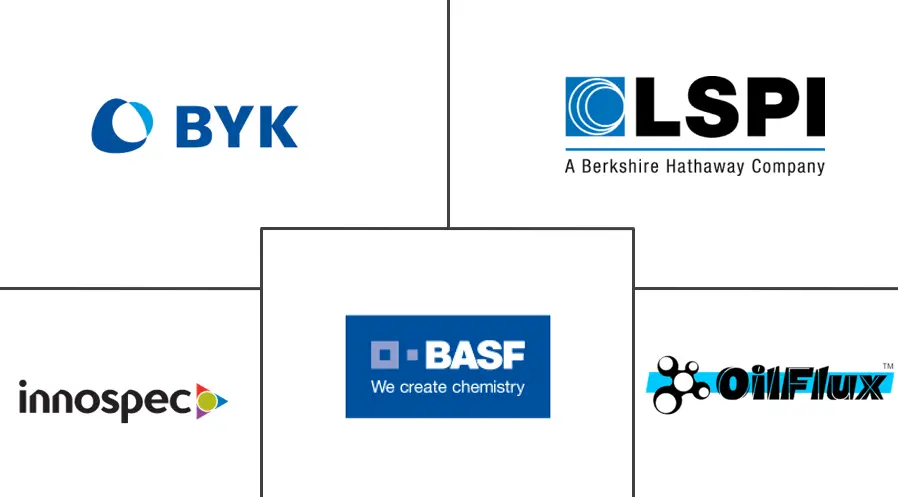Viscosity Reducing Agents Market Size and Share
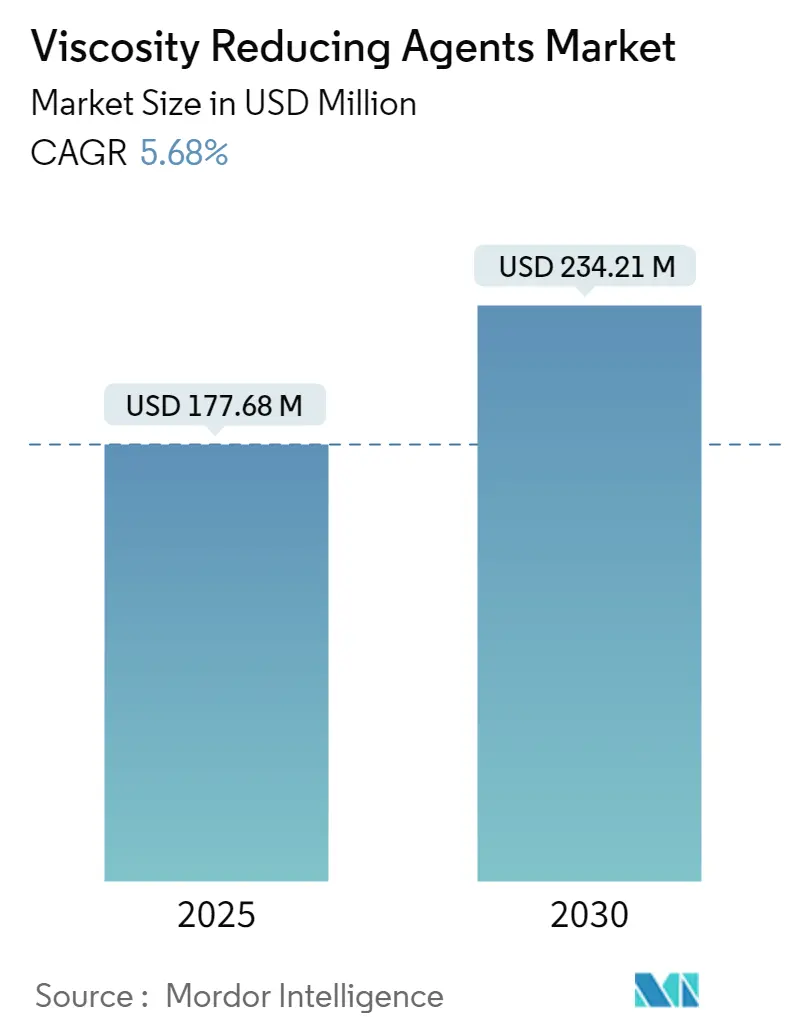
Viscosity Reducing Agents Market Analysis by Mordor Intelligence
The Viscosity Reducing Agents Market size is estimated at USD 177.68 million in 2025, and is expected to reach USD 234.21 million by 2030, at a CAGR of 5.68% during the forecast period (2025-2030).
Growing demand from the oil & gas industry along with other drives are driving the market. On the flip side, stringent environmental regulations coupled with unfavorable conditions arising due to the COVID-19 outbreak are hindering the market growth.
- The Viscosity Reducing Agents market is expected to grow during the forecast period owing to the growing demand from the oil & gas industry.
- Asia-Pacific region to dominate the market across the globe with the largest consumption from countries such as China and India.
Global Viscosity Reducing Agents Market Trends and Insights
Growing Demand from the Oil & Gas Industry
- Viscosity reducing agents are widely used in oil & gas industries and is expected to grow rapidly during the forecast period.
- Viscosity reducing agents are often referred to as drag reducing agents in oil & gas industries, they improve the flow by reducing the frictional energy losses by decreasing the turbulence in the pipeline during crude oil transportation, and processing.
- Moreover, they are long-chain hydrocarbons that decrease the pressure drop for the same flow rate and thereby increase the pipeline flow using the same amount of energy.
- Viscosity reducing agents help in the free-flowing of crude oil products, finished products, asphalt-crude, aqueous systems, and multiphase systems. The global petroleum and other petroleum-based liquids are at 100.75 million barrels per day in 2019 from 99.97 million barrels per day in 2018, which shows an increase of about 284.7 million barrels per year and is expected to grow during the forecast period.
- However, due to unprecedented conditions arisen due to the COVID-19 outbreak the consumption of oil & gas will be down by at least 5 million barrels per day due to lockdown in various countries and shut down of travel, tourism, e-commerce, and restaurants are likely to affect the consumption in 2020.
- The growing urbanization and increasing demand for petroleum-based products are expected to drive the market for the viscosity reducing agents during the forecast period.
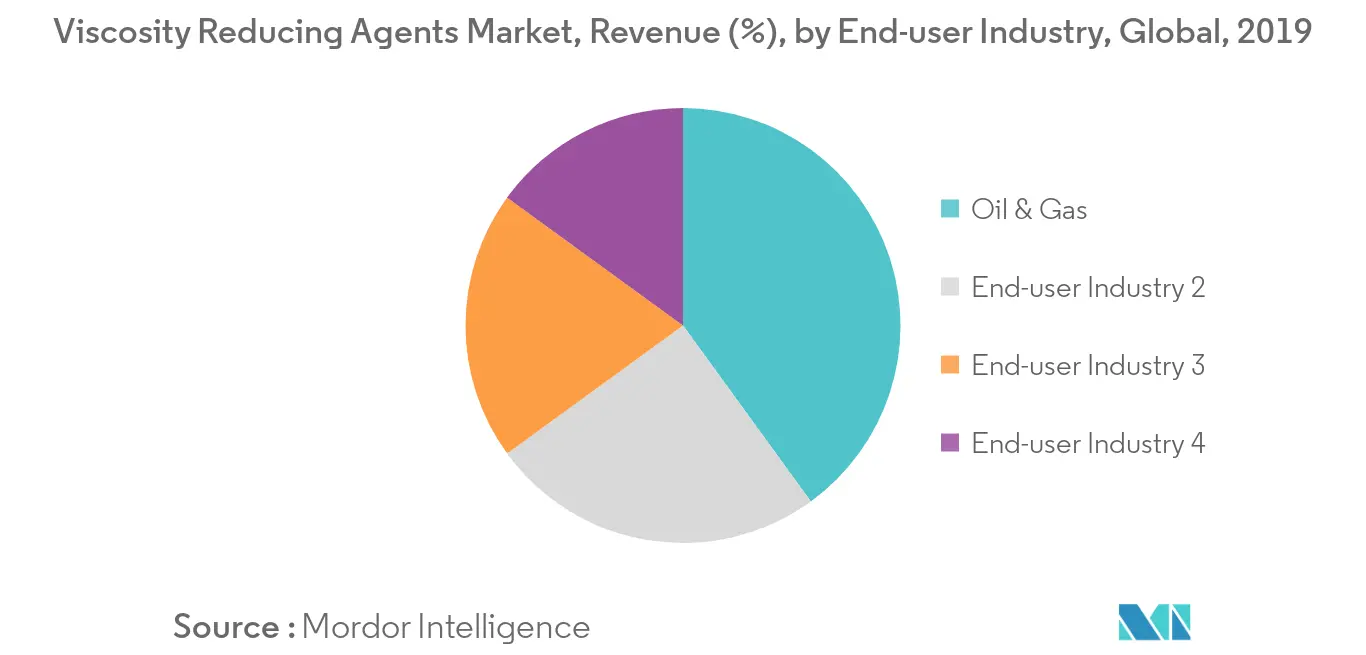
Asia-Pacific Region to Dominate the Market
- The Asia-Pacific region is expected to dominate the market for viscosity reducing agents during the forecast period due to an increase in demand from countries like China and India.
- The growing crude-oil consumption in countries like India and China is expected to drive the market during the forecast period. Globally, India is the third-largest consumer of crude oil and petroleum products after China and the United States, with the second-largest refinery in Asia after China. The Indian petroleum import value is about USD 112 billion in 2019 with a 27% growth from the financial year 2018. The growing consumption from the transportation sector, and liquified petroleum gas from residential and commercial complexes are expected to drive the market.
- In China, crude oil consumption is at 14.5 million barrels per day in 2019 from about 13.5 million barrels per day in 2018. In addition to that, China's refinery capacity is increased by 1 million barrels per day in 2019. The growing consumption in China is expected to drive the market.
- In paints & coatings, the dispersing agents deflocculates solids, thereby reducing the viscosity of dispersion and increasing the loading of dispersed powder material. The dispersing phase is the most energy consuming stage and dispersing agents help in increasing stability and optimize energy consumption. The growing paints and coatings are expected to drive the market.
- The aforementioned factors, coupled with government support, are contributing to the increasing demand for viscosity reducing agents market in the Asia-Pacific during the forecast period.
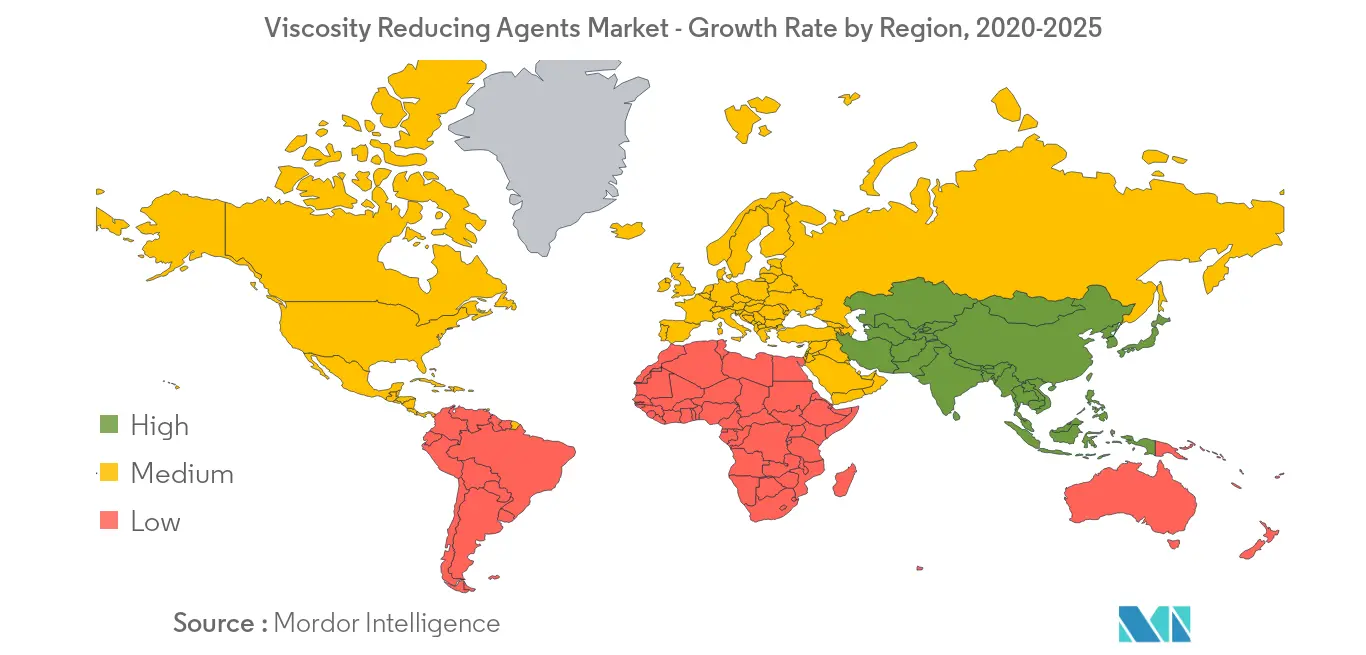
Competitive Landscape
The global viscosity reducing agents market is partially fragmented with players accounting for a marginal share of the market. Few companies include BYK-CHEMIE GMBH, LiquidPower Specialty Products Inc., Innospec, Oil Flux, and BASF SE.
Viscosity Reducing Agents Industry Leaders
-
BYK-CHEMIE GMBH
-
LiquidPower Specialty Products Inc.
-
Innospec
-
Oil Flux
-
BASF SE
- *Disclaimer: Major Players sorted in no particular order
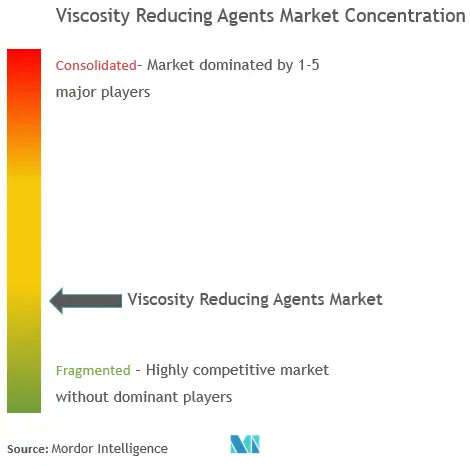
Global Viscosity Reducing Agents Market Report Scope
The Viscosity Reducing Agents Market report include:
| Drag Reducing Agents |
| Surfactants & Additives |
| Dispersing Agents |
| Others |
| Oil & Gas |
| Paints & Coatings |
| Plastics |
| Other Manufacturing Industries |
| Asia-Pacific | China |
| India | |
| Japan | |
| South Korea | |
| Rest of Asia-Pacific | |
| North America | United States |
| Canada | |
| Mexico | |
| Europe | Germany |
| United Kingdom | |
| Italy | |
| France | |
| Rest of Europe | |
| South America | Brazil |
| Argentina | |
| Rest of South America | |
| Middle-East and Africa | Saudi Arabia |
| South Africa | |
| Rest of Middle-East and Africa |
| Type | Drag Reducing Agents | |
| Surfactants & Additives | ||
| Dispersing Agents | ||
| Others | ||
| End-user Industry | Oil & Gas | |
| Paints & Coatings | ||
| Plastics | ||
| Other Manufacturing Industries | ||
| Geography | Asia-Pacific | China |
| India | ||
| Japan | ||
| South Korea | ||
| Rest of Asia-Pacific | ||
| North America | United States | |
| Canada | ||
| Mexico | ||
| Europe | Germany | |
| United Kingdom | ||
| Italy | ||
| France | ||
| Rest of Europe | ||
| South America | Brazil | |
| Argentina | ||
| Rest of South America | ||
| Middle-East and Africa | Saudi Arabia | |
| South Africa | ||
| Rest of Middle-East and Africa | ||
Key Questions Answered in the Report
How big is the Viscosity Reducing Agents Market?
The Viscosity Reducing Agents Market size is expected to reach USD 177.68 million in 2025 and grow at a CAGR of 5.68% to reach USD 234.21 million by 2030.
What is the current Viscosity Reducing Agents Market size?
In 2025, the Viscosity Reducing Agents Market size is expected to reach USD 177.68 million.
Who are the key players in Viscosity Reducing Agents Market?
BYK-CHEMIE GMBH, LiquidPower Specialty Products Inc., Innospec, Oil Flux and BASF SE are the major companies operating in the Viscosity Reducing Agents Market.
Which is the fastest growing region in Viscosity Reducing Agents Market?
Asia Pacific is estimated to grow at the highest CAGR over the forecast period (2025-2030).
Which region has the biggest share in Viscosity Reducing Agents Market?
In 2025, the Asia Pacific accounts for the largest market share in Viscosity Reducing Agents Market.
What years does this Viscosity Reducing Agents Market cover, and what was the market size in 2024?
In 2024, the Viscosity Reducing Agents Market size was estimated at USD 167.59 million. The report covers the Viscosity Reducing Agents Market historical market size for years: 2019, 2020, 2021, 2022, 2023 and 2024. The report also forecasts the Viscosity Reducing Agents Market size for years: 2025, 2026, 2027, 2028, 2029 and 2030.
Page last updated on:
Viscosity Reducing Agents Market Report
Statistics for the 2025 Viscosity Reducing Agents market share, size and revenue growth rate, created by Mordor Intelligence™ Industry Reports. Viscosity Reducing Agents analysis includes a market forecast outlook for 2025 to 2030 and historical overview. Get a sample of this industry analysis as a free report PDF download.
